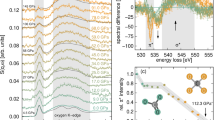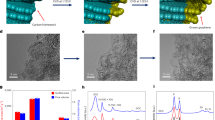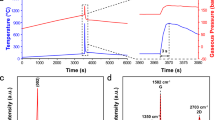Abstract
IT has been said that the degree of graphitization of carbon depends chiefly on the highest temperature of heat treatment and that other conditions of heat treatment, such as holding time, are of secondary importance. However, it was previously reported1that the vacuum-evaporated carbon was scarcely graphitized in vacuum, although it was easily graphitized under atmospheric pressure. Therefore, we thought it necessary to study the effect of the gas phase of heat treatment on the graphitization of carbon. In order to investigate this effect, a calcined petroleum coke was heat-treated under various pressures and its lattice constant c0was measured by means of X-ray diffraction method using extra-pure silicon powder as an inner standard.
This is a preview of subscription content, access via your institution
Access options
Subscribe to this journal
Receive 51 print issues and online access
$199.00 per year
only $3.90 per issue
Buy this article
- Purchase on SpringerLink
- Instant access to full article PDF
Prices may be subject to local taxes which are calculated during checkout
Similar content being viewed by others
References
Noda, T., and Matsuoka, H., J. Chem. Soc. Japan, Indust. Chem. Sec., 64, 2083 (1961).
Inagaki, M., and Noda, T., Bull. Chem. Soc. Japan, 35, 1652 (1962).
Mrozowski, S., Proc. First and Second Conf. on Carbon, 31 (Univ. of Buffalo, 1956).
Okada, J., et al., Proc. Fifth Conf. on Carbon (in the press).
Author information
Authors and Affiliations
Rights and permissions
About this article
Cite this article
NODA, T., INAGAKI, M. Heat Treatment of Carbon under Various Pressures. Nature 196, 772 (1962). https://doi.org/10.1038/196772a0
Issue date:
DOI: https://doi.org/10.1038/196772a0
This article is cited by
-
Phenomena of catalytic graphitization
Journal of Materials Science (1982)



